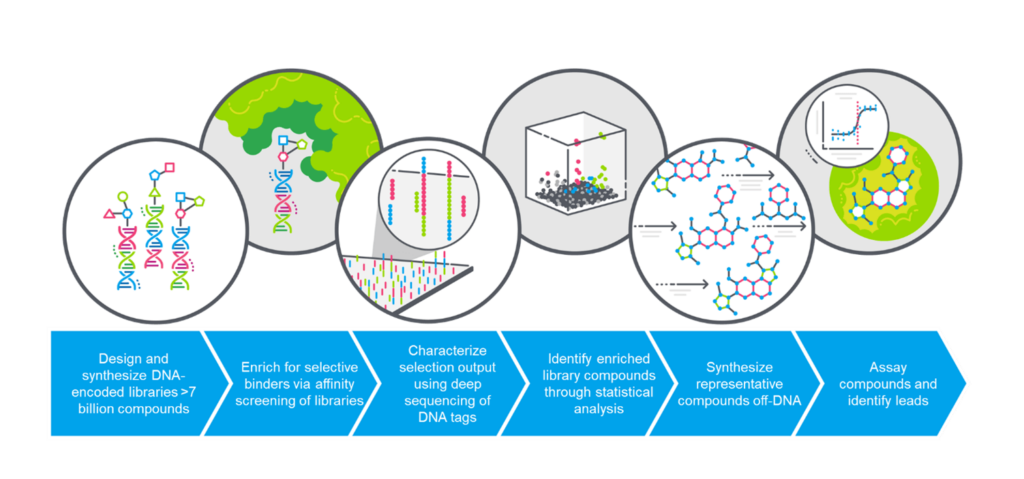Through the Lens of a Lead Discovery Scientist: Enabling Hit Identification Through DNA-Encoded Libraries
The phrase “you miss 100% of the shots you don’t take” was originally coined by Wayne Gretzky about scoring goals in hockey, but this saying is equally relevant to small molecule hit identification. When initiating a new drug discovery program, identifying high-quality chemical series for hit-to-lead optimization is essential for success. Approaches to identify novel chemical series are ever-expanding, including traditional high-throughput screening, fragment-based discovery and computational methods. Among these hit-finding approaches, DNA-encoded chemical libraries (DELs) offer an efficient and cost-effective avenue toward de novo small molecule hit identification. DELs afford a path to lead molecules through focused optimization, applying screening data directly to medicinal chemistry. By utilizing the screening data to inform analog design and optimization, fewer cycles of chemistry are capable of producing valuable lead molecules.
X-Chem’s traditional DEL offerings provide a full-service package for hit identification — including project-specific quality control of screening reagents, DEL screening performed at X-Chem, analysis by an expert scientist and compound synthesis for off-DNA testing and assay.

Customers who wish to take a more involved role in their project can now leverage our DELenable platform, a user-guided discovery engine. DELenable allows researchers to perform the DNA-encoded library screen themselves, access the screening results through a self-service user interface and consult with DEL experts here at X-Chem to maximize their project’s productivity. This imparts a level of autonomy and participation in the DEL process that has not been possible previously. This becomes particularly valuable for programs where the desired mechanism of action (MoA) may be complicated or when target biomolecules require specific considerations that may be better supported internally.
One advantage of the DELenable offering is the ability to tailor the experimental design and analysis of the screen to each target being interrogated — including assessment of selectivity, binding kinetics and particular mechanism of actions. For example, our recent report in collaboration with AstraZeneca describes the DEL-mediated identification of multiple unique chemical series targeting MerTK, a tyrosine kinase implicated in cancer progression. Through a multiplexed DEL screen, type I, type III and “type I ½” inhibitors were identified, enabling future optimization and development efforts across several distinct mechanisms of action. The co-crystal structure shown below depicts the interaction between two of the DEL hits and MerTK. The green molecule exhibits a binding pose consistent with type I ATP-competitive inhibition, and the cyan molecule displays type III inhibition, binding an allosteric site within the ATP pocket. The DEL selection data directly corroborated these mechanisms of action, affirming the notion that a screening experiment can be successfully prosecuted with MoA in mind.

By utilizing X-Chem’s DELenable platform, clients will be empowered to utilize their DEL screening data.
DEL screening enablement consists of multiple distinct components that work in unison to facilitate small molecule hit identification. From the initial wet laboratory work performing the affinity-mediated DEL screen through the process of data analysis including structure-activity relationship clustering, each aspect plays a critical role in the platform.

In each enablement process, we provide the fundamental requirements that underpin a successful and productive DEL screen: First, the importance of target quality control and reagent generation. I sometimes compare a screen to “going fishing” — your biomolecular target is the bait and our DNA-encoded libraries are the fish. If you don’t validate the purity, homogeneity and activity of your target, instead of catching an ahi tuna, you’ll likely end up with a shoe or two! Protein aggregates tend to recruit hydrophobic library members which bind in nonspecific ways to unproductively folded species. Similarly, if the protein is not active or functional, relevant binding sites may not be available for DEL members to interact with. Providing explicit guidance on how to experimentally qualify the target of interest is part of the DELenable process to ensure that high-quality results are generated.

Additionally, a good understanding of the desired binding mode and mechanism of action is necessary to maximize the DEL screening output and generate productive analyses. Since a DELenable screen includes over 7 billion unique small molecule library members, there is considerable data to sift through from a single day of wet labwork! Through DELenable, a chemist is empowered to mine the DEL screening data to identify hit structures, assessing SAR and physicochemical properties to guide hit resynthesis decisions and subsequent validation efforts. Data handling is performed in our X-Chem Web Portal, where you can upload raw sequencing files, receive analysis-ready data files for hit-finding activities and access DEL-related resources for maximizing the success of your DELenable projects. The computational and informatic expertise that have driven the success of many projects at X-Chem are now offered for client use for the first time through the Web Portal. Throughout this process, X-Chem’s scientific team may provide guidance and respond to any inquiries about the experimental or analytical nuances of DEL.
Why choose to pursue DELenable over a traditional screening model? There are various reasons one would assume the responsibility of performing the DEL screen themselves — one being as simple as having a temperamental protein that may not survive shipping and long-term storage. Perhaps the identity of the target and desired mechanism of action are novel and maintaining privacy around these details is highly valued. Whatever the case may be, X-Chem has established a straightforward workflow in which a client may internalize DEL screening but still engage our expertise to maximize productivity and success. During my tenure as a lead discovery scientist at X-Chem, I have worked with multiple clients to enable DEL screening in their own laboratories with great success, and I look forward to working with you on future projects!
Flow Chemistry for Contemporary Isotope Labeling
Isotope-labeled compounds have emerged as important tools in drug discovery and development. The incorporated isotopes, particularly deuterium, in pharmaceuticals, have...
Driving Discovery Through Miniaturized High-Throughput Chemistry
When chemists approach the formation of a new bond, they often choose reaction conditions that they (or their colleagues) are...